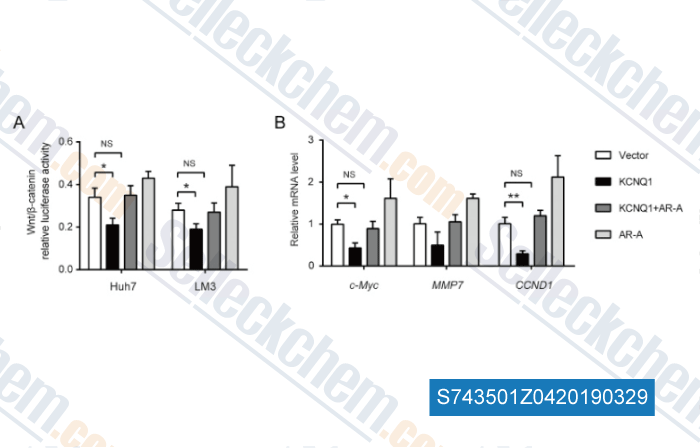|
Toll Free: (877) 796-6397 -- USA and Canada only -- |
Fax: +1-832-582-8590 Orders: +1-832-582-8158 |
Tech Support: +1-832-582-8158 Ext:3 Please provide your Order Number in the email. |
Technical Data
| Formula | C12H12N4O4S |
|||
| Molecular Weight | 308.31 | CAS No. | 487021-52-3 | |
| Solubility (25°C)* | In vitro | DMSO | 62 mg/mL (201.09 mM) | |
| Water | Insoluble | |||
| Ethanol | Insoluble | |||
|
* <1 mg/ml means slightly soluble or insoluble. * Please note that Selleck tests the solubility of all compounds in-house, and the actual solubility may differ slightly from published values. This is normal and is due to slight batch-to-batch variations. * Room temperature shipping (Stability testing shows this product can be shipped without any cooling measures.) |
||||
Preparing Stock Solutions
Biological Activity
| Description | AR-A014418 (GSK-3β Inhibitor VIII) is an ATP-competitive, and selective GSK3β inhibitor with IC50 and Ki of 104 nM and 38 nM in cell-free assays, without significant inhibition on 26 other kinases tested. | ||||
|---|---|---|---|---|---|
| Targets |
|
||||
| In vitro | AR-A014418 inhibits tau phosphorylation at a GSK3-specific site (Ser-396) in 3T3 fibroblasts expressing human four-repeat tau protein with IC50 of 2.7 μM, and protects cultured N2A cells from death induced by blocking PI3K/PKB pathway. In hippocampal slices, AR-A014418 inhibits neurodegeneration mediated by beta-amyloid peptide. [1] While in NGP and SH-5Y-SY cells, AR-A014418 reduces neuroendocrine markers and suppresses neuroblastoma cell growth. [2] | ||||
| In vivo | In ALS mouse model with the G93A mutant human SOD1, AR-A014418 (0-4 mg/kg, i.p.) delays the onset of symptoms, improves motor activity, slows down disease progression, and postpons the endpoint of the disease. [3] In addition, AR-A014418 produces inhibition effect on acetic acid- and formalin-induced nociception in mice by modulating NMDA and metabotropic receptor signaling as well as TNF-α and IL-1β transmission in the spinal cord. [4] | ||||
| Features | Cell-permeable GSK3-selective inhibitor. |
Protocol (from reference)
| Kinase Assay: |
|
|---|---|
| Cell Assay: |
|
| Animal Study: |
|
References
Customer Product Validation

-
Data from [Data independently produced by , , Cell Physiol Biochem, 2017, 42(3):1177-1191]

-
Data from [Data independently produced by , , Biochem Biophys Res Commun, 2018, 503(4):3100-3107]
Selleck's AR-A014418 has been cited by 21 publications
| Targeting ErbB and tankyrase1/2 prevent the emergence of drug-tolerant persister cells in ALK-positive lung cancer [ NPJ Precis Oncol, 2024, 8(1):264] | PubMed: 39551860 |
| Deficiencies in corin and atrial natriuretic peptide-mediated signaling impair endochondral ossification in bone development [ Commun Biol, 2024, 7(1):1380] | PubMed: 39443661 |
| Establishment and characterization of immortalized sweat gland myoepithelial cells [ Sci Rep, 2022, 12(1):7] | PubMed: 34997030 |
| Discovery of Novel Tacrine-Pyrimidone Hybrids as Potent Dual AChE/GSK-3 Inhibitors for the Treatment of Alzheimer's Disease [ J Med Chem, 2021, 64(11):7483-7506] | PubMed: 34024109 |
| Caspase-9 acts as a regulator of necroptotic cell death [ FEBS J, 2021, 10.1111/febs.15898] | PubMed: 33899329 |
| SOX2 enhances cell survival and induces resistance to apoptosis under serum starvation conditions through the AKT/GSK-3β signaling pathway in esophageal squamous cell carcinoma [ Oncol Lett, 2021, 21(4):269] | PubMed: 33717266 |
| Ribosomal S6 protein kinase 4 promotes radioresistance in esophageal squamous cell carcinoma [ J Clin Invest, 2020, 130(8):4301-4319] | PubMed: 32396532 |
| Suppression of histone deacetylases by SAHA relieves bone cancer pain in rats via inhibiting activation of glial cells in spinal dorsal horn and dorsal root ganglia. [ J Neuroinflammation, 2020, 22;17(1):125] | PubMed: 32321538 |
| Differences in the Sensitivity of Classically and Alternatively Activated Macrophages to TAK1 Inhibitor-Induced Necroptosis [ Cancer Immunol Immunother, 2020, 29] | PubMed: 32472370 |
| Resveratrol targets PD-L1 glycosylation and dimerization to enhance antitumor T-cell immunity. [ Aging (Albany NY), 2020, 12(1):8-34] | PubMed: 31901900 |
RETURN POLICY
Selleck Chemical’s Unconditional Return Policy ensures a smooth online shopping experience for our customers. If you are in any way unsatisfied with your purchase, you may return any item(s) within 7 days of receiving it. In the event of product quality issues, either protocol related or product related problems, you may return any item(s) within 365 days from the original purchase date. Please follow the instructions below when returning products.
SHIPPING AND STORAGE
Selleck products are transported at room temperature. If you receive the product at room temperature, please rest assured, the Selleck Quality Inspection Department has conducted experiments to verify that the normal temperature placement of one month will not affect the biological activity of powder products. After collecting, please store the product according to the requirements described in the datasheet. Most Selleck products are stable under the recommended conditions.
NOT FOR HUMAN, VETERINARY DIAGNOSTIC OR THERAPEUTIC USE.
